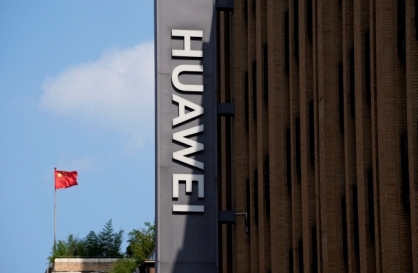You’ve probably never heard of Taunus Corp., but according to the Federal Reserve, it’s the U.S.’s eighth-largest bank holding company. Taunus, it turns out, is the North American subsidiary of Germany’s Deutsche Bank AG, with assets of just over $380 billion.
Deutsche Bank holds a large amount of European government and bank debt; it also has considerable exposure to lingering real estate problems in the U.S. The bank, therefore, could become a conduit for risk between the two economies. But which way is Deutsche Bank more likely to transmit danger ― to or from the U.S.?
By any measure, Deutsche Bank is a giant. Its assets at the end of September totaled 2.28 trillion euros (according to the bank’s own website), or $3.08 trillion. In the latest ranking from The Banker, which uses 2010 data, Deutsche was the second-largest bank in the world by assets, behind only BNP Paribas SA.
The German bank, however, is thinly capitalized. Its total equity at the end of the third quarter was only 51.9 billion euros, implying a leverage ratio (total assets divided by equity) of almost 44. This is up from the second quarter, when leverage was about 36 (assets were 1.849 trillion euros and capital was 51.678 billion euros.)
Even by modern standards, this is very high leverage. JPMorgan Chase & Co. has a balance sheet about 20 percent smaller than Deutsche Bank’s, but more than twice as much Tier 1 capital, an important indicator of a bank’s financial strength. Bank of America Corp., whose weakness is a serious worry in the U.S. today, has twice Deutsche’s capital. (These comparisons use The Banker’s ranking of the top 25 banks.)
Globally, Deutsche’s capital ratios are relatively healthy, judging by the banking industry’s standard measures. At the end of the third quarter, its Tier 1 capital ratio was 13.8 percent (up from 12.3 percent at the end of 2010) and its core Tier 1, which excludes hybrid debt that can convert into equity, was 10.1 percent.
How does such a highly leveraged bank become “well-capitalized”? The answer is that “risk-weighted assets” were 337.6 billion euros as of Sept. 30. But what is a low risk-weight asset in the European context today? Incredibly, it is sovereign debt, which of course is far from riskless at the moment.
Perhaps Deutsche Bank holds mostly German government debt, which still has safe-haven value. But it’s likely that Deutsche also holds a significant amount of Italian and French government bonds.
Still, the bigger risks are probably in the U.S. Deutsche Bank is a significant trustee for mortgages, having been heavily involved in the issuance and distribution of mortgage-backed securities during the housing bubble. Yves Smith, writing on the nakedcapitalism.com blog, says Deutsche Bank is one of the U.S.’s four biggest securitization trustees. Many questions on whether paperwork was done properly and whether the rights of investors have been protected hang over these trusts.
Let’s take a look just at Taunus Corp., named after a range of mountains outside the parent bank’s Frankfurt headquarters. The latest figures (from the Fed data, using the consolidated financial statement at the end of the third quarter) show Taunus with total equity capital of just $4.876 billion. This implies an eye-popping leverage ratio of around 78.
Why would the Federal Reserve and the new council of regulators known as the Financial Stability Oversight Council allow Deutsche Bank to operate in the U.S. with sky-high leverage ― with its huge implied risk to the rest of the financial system? Presumably, in the past, U.S. authorities have taken the view that Deutsche Bank had a strong enough balance sheet worldwide that more capital could be provided to its American subsidiary, if needed.
Such a presumption now seems questionable, at best. Earlier this year, Bloomberg News reported that Taunus needed almost $20 billion of additional funds to meet U.S. capital standards, and that Deutsche Bank was trying to declassify Taunus as a bank-holding company to avoid capital requirements entirely. It’s unclear where this process now stands, but it’s also not obvious how declassification would help U.S. or global financial stability. Financial reform advocates hopefully will press hard on this issue.
All of this raises troubling questions. Have U.S. bank supervisors really satisfied themselves, through onsite inspections, that Deutsche Bank’s risk weights accurately reflect market conditions and the increasing structural weakness of the euro area? Can U.S. regulators document their satisfaction beyond the materials produced for the European Banking Authority, which earlier this year oversaw stress tests that pronounced now-collapsed Dexia as well-capitalized? (Actually, Dexia had stronger capital ratios than Deutsche Bank.)
In their prescient, pre-crisis book, “Too Big To Fail” (not to be confused with the more recent Andrew Ross Sorkin book of the same title), Gary H. Stern and Ron J. Feldman, in 2004 nailed the incentive distortions that encouraged risk-taking and brought the financial sector to its knees. No one else came close to them in getting this right. Included in their analysis are examples of banks that could have been regarded as having moral hazard issues because of their size. Deutsche Bank is No. 4 on their list of large, complex banking organizations by asset size.
This dog did not bark during the 2008 crisis, partly because most foreign governments were seen as having strong enough balance sheets to back their banks’ worldwide operations. But this is no longer necessarily true for euro-area governments.
Even in 2008-09, this may have been illusory. According to published reports, Deutsche Bank received considerable assistance from the Federal Reserve, including $11.8 billion through the American International Group bailout and $2 billion through the Fed’s discount window. Deutsche was the second-largest discount-window borrower and the largest user of the Fed’s Term Asset-Backed Securities Lending Facility during the crisis.
Deutsche Bank and, if necessary, the German government should be required to inject substantially more capital into Taunus. Allowing business as usual is asking for trouble, particularly as Deutsche wants to remain focused on relatively risky investment banking. Recently it named as chairman Paul Achleitner, the finance director at Allianz SE, the German insurance company, and an ex-Goldman Sachs executive, worrying even some of its shareholders.
This would be a good time for Congress to dig more deeply into the risks that Deutsche Bank poses to financial stability in the U.S. and around the world.
By Simon Johnson
Simon Johnson, who served as chief economist at the International Monetary Fund in 2007 and 2008, and is now a professor at the MIT Sloan School of Management, is a Bloomberg View columnist. The opinions expressed are his own. ― Ed.
(Bloomberg)
Deutsche Bank holds a large amount of European government and bank debt; it also has considerable exposure to lingering real estate problems in the U.S. The bank, therefore, could become a conduit for risk between the two economies. But which way is Deutsche Bank more likely to transmit danger ― to or from the U.S.?
By any measure, Deutsche Bank is a giant. Its assets at the end of September totaled 2.28 trillion euros (according to the bank’s own website), or $3.08 trillion. In the latest ranking from The Banker, which uses 2010 data, Deutsche was the second-largest bank in the world by assets, behind only BNP Paribas SA.
The German bank, however, is thinly capitalized. Its total equity at the end of the third quarter was only 51.9 billion euros, implying a leverage ratio (total assets divided by equity) of almost 44. This is up from the second quarter, when leverage was about 36 (assets were 1.849 trillion euros and capital was 51.678 billion euros.)
Even by modern standards, this is very high leverage. JPMorgan Chase & Co. has a balance sheet about 20 percent smaller than Deutsche Bank’s, but more than twice as much Tier 1 capital, an important indicator of a bank’s financial strength. Bank of America Corp., whose weakness is a serious worry in the U.S. today, has twice Deutsche’s capital. (These comparisons use The Banker’s ranking of the top 25 banks.)
Globally, Deutsche’s capital ratios are relatively healthy, judging by the banking industry’s standard measures. At the end of the third quarter, its Tier 1 capital ratio was 13.8 percent (up from 12.3 percent at the end of 2010) and its core Tier 1, which excludes hybrid debt that can convert into equity, was 10.1 percent.
How does such a highly leveraged bank become “well-capitalized”? The answer is that “risk-weighted assets” were 337.6 billion euros as of Sept. 30. But what is a low risk-weight asset in the European context today? Incredibly, it is sovereign debt, which of course is far from riskless at the moment.
Perhaps Deutsche Bank holds mostly German government debt, which still has safe-haven value. But it’s likely that Deutsche also holds a significant amount of Italian and French government bonds.
Still, the bigger risks are probably in the U.S. Deutsche Bank is a significant trustee for mortgages, having been heavily involved in the issuance and distribution of mortgage-backed securities during the housing bubble. Yves Smith, writing on the nakedcapitalism.com blog, says Deutsche Bank is one of the U.S.’s four biggest securitization trustees. Many questions on whether paperwork was done properly and whether the rights of investors have been protected hang over these trusts.
Let’s take a look just at Taunus Corp., named after a range of mountains outside the parent bank’s Frankfurt headquarters. The latest figures (from the Fed data, using the consolidated financial statement at the end of the third quarter) show Taunus with total equity capital of just $4.876 billion. This implies an eye-popping leverage ratio of around 78.
Why would the Federal Reserve and the new council of regulators known as the Financial Stability Oversight Council allow Deutsche Bank to operate in the U.S. with sky-high leverage ― with its huge implied risk to the rest of the financial system? Presumably, in the past, U.S. authorities have taken the view that Deutsche Bank had a strong enough balance sheet worldwide that more capital could be provided to its American subsidiary, if needed.
Such a presumption now seems questionable, at best. Earlier this year, Bloomberg News reported that Taunus needed almost $20 billion of additional funds to meet U.S. capital standards, and that Deutsche Bank was trying to declassify Taunus as a bank-holding company to avoid capital requirements entirely. It’s unclear where this process now stands, but it’s also not obvious how declassification would help U.S. or global financial stability. Financial reform advocates hopefully will press hard on this issue.
All of this raises troubling questions. Have U.S. bank supervisors really satisfied themselves, through onsite inspections, that Deutsche Bank’s risk weights accurately reflect market conditions and the increasing structural weakness of the euro area? Can U.S. regulators document their satisfaction beyond the materials produced for the European Banking Authority, which earlier this year oversaw stress tests that pronounced now-collapsed Dexia as well-capitalized? (Actually, Dexia had stronger capital ratios than Deutsche Bank.)
In their prescient, pre-crisis book, “Too Big To Fail” (not to be confused with the more recent Andrew Ross Sorkin book of the same title), Gary H. Stern and Ron J. Feldman, in 2004 nailed the incentive distortions that encouraged risk-taking and brought the financial sector to its knees. No one else came close to them in getting this right. Included in their analysis are examples of banks that could have been regarded as having moral hazard issues because of their size. Deutsche Bank is No. 4 on their list of large, complex banking organizations by asset size.
This dog did not bark during the 2008 crisis, partly because most foreign governments were seen as having strong enough balance sheets to back their banks’ worldwide operations. But this is no longer necessarily true for euro-area governments.
Even in 2008-09, this may have been illusory. According to published reports, Deutsche Bank received considerable assistance from the Federal Reserve, including $11.8 billion through the American International Group bailout and $2 billion through the Fed’s discount window. Deutsche was the second-largest discount-window borrower and the largest user of the Fed’s Term Asset-Backed Securities Lending Facility during the crisis.
Deutsche Bank and, if necessary, the German government should be required to inject substantially more capital into Taunus. Allowing business as usual is asking for trouble, particularly as Deutsche wants to remain focused on relatively risky investment banking. Recently it named as chairman Paul Achleitner, the finance director at Allianz SE, the German insurance company, and an ex-Goldman Sachs executive, worrying even some of its shareholders.
This would be a good time for Congress to dig more deeply into the risks that Deutsche Bank poses to financial stability in the U.S. and around the world.
By Simon Johnson
Simon Johnson, who served as chief economist at the International Monetary Fund in 2007 and 2008, and is now a professor at the MIT Sloan School of Management, is a Bloomberg View columnist. The opinions expressed are his own. ― Ed.
(Bloomberg)






![[KH Explains] Can tech firms' AI alliances take on Nvidia?](http://res.heraldm.com/phpwas/restmb_idxmake.php?idx=644&simg=/content/image/2024/05/07/20240507050619_0.jpg&u=)


![[Grace Kao, Meera Choi] Has money displaced romance on dates?](http://res.heraldm.com/phpwas/restmb_idxmake.php?idx=644&simg=/content/image/2024/05/06/20240506050233_0.jpg&u=)







![[K-pop’s dilemma] Time, profit pressures work against originality](http://res.heraldm.com/phpwas/restmb_idxmake.php?idx=652&simg=/content/image/2024/05/08/20240508050705_0.jpg&u=20240508171126)
![[Today’s K-pop] NCT Dream to drop pre-release from 2nd Japan single](http://res.heraldm.com/phpwas/restmb_idxmake.php?idx=642&simg=/content/image/2024/05/08/20240508050725_0.jpg&u=)